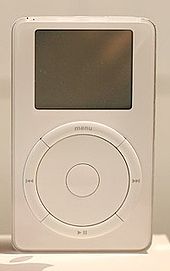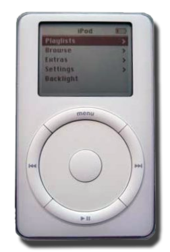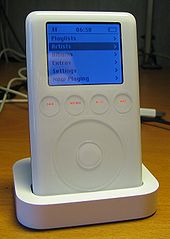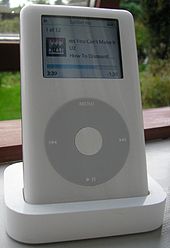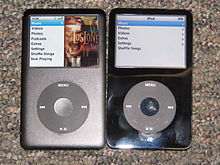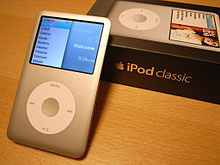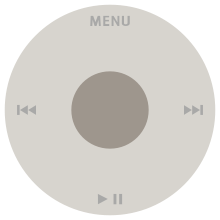- iPod Classic
-

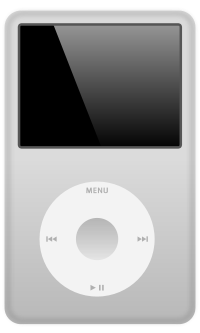
iPod Classic (6th generation)Manufacturer Apple Inc. Retail availability October 23, 2001 – present Media Hard drive
From 5–160 GB (currently 160 GB)Operating system 1.5 (1G, 2G)
2.3 (3G)
3.1.1 (4G)
1.2.1 (4G Color)
1.3 (5G)
1.1.2 (6G)
2.0.4 (6.5G)Display 1G-4G: 160 x 128 px, 2 in (51 mm), monochrome LCD
Color: 220 x 176 px, 2 in (51 mm), color LCD
5G-6G: 320 x 240 px, 2.5 in (64 mm), color LCDInput 4G-6G: Click wheel
1G: Scroll wheel
2G-3G: Touch wheelConnectivity 3G-6G: USB 2.0
1G-4G: FireWireRelated articles iPod Shuffle
iPod Nano
iPod Touch
iPhoneThe iPod Classic (trademarked, marketed, and stylized as iPod classic and known before its sixth generation as simply iPod) is a portable media player marketed by Apple Inc. The current generation is by far the most capacious iPod, with 160GB of storage.
To date, there have been six generations of the iPod, as well as a spin-off (the iPod Photo) that was later re-integrated into the main iPod line. (Some sources incorrectly refer to the revisions of the sixth generation as a separate "seventh generation."[1]) All generations use a 1.8-inch (46 mm) hard drive for storage. The "classic" suffix was initially introduced when a freelance writer analyzing eBay's used/broken iPod marketplace categorized iPods into different types on May 21, 2006 [2] and was formally introduced with the introduction of the sixth-generation iPod on September 5, 2007 [3] prior to this, all iPod models were simply referred to as iPods.[4] It is available in silver or black replacing the "signature iPod white".
Contents
History
First generation
Apple introduced the first-generation iPod on October 23, 2001, with the slogan "1,000 songs in your pocket". The first iPod had a black and white LCD (liquid-crystal display) screen and featured a 5 GB hard drive capable of storing 1,000 songs encoded using MP3 and was priced at US$399. Among the iPod's innovations were its small size, achieved using a 1.8" hard drive, whereas its competitors were using 2.5" hard drives at the time, and its easy-to-use navigation, which was controlled using a mechanical scroll wheel (unlike later iPods, which had touch-sensitive scroll wheels), a center select button, and four auxiliary buttons around the wheel. The iPod had a rated battery life of ten hours.
On March 20, 2002, Apple introduced a 10 GB model of the first generation iPod for US$499. vCard compatibility was added, as well, allowing iPods to display business card information synced from a Mac.
Second generation
The second generation iPod was introduced on July 17, 2002. Using the same body style as the first generation, the hold switch was redesigned, a cover was added to the FireWire port, and the mechanical wheel was replaced with a touch-sensitive wheel. The front plate also had rounded corners and edges. The second-generation class was available in 10 GB for US$399 and 20 GB for US$499. The first-generation 5 GB iPod was carried over, but its price was reduced to US$299.
Notably, Apple began selling Windows-compatible versions of the iPod starting with the second generation. These versions came with a 4-pin to 6-pin FireWire adapter and were bundled with Musicmatch Jukebox instead of iTunes.
In December 2002, Apple unveiled its first limited edition iPods, with either Madonna’s, Tony Hawk’s, or Beck’s signature or No Doubt's band logo engraved on the back for an extra US$50.[5]
Third generation
On April 29, 2003, Apple announced a completely redesigned third-generation iPod. Thinner than the previous models, the third generation models replaced the FireWire port with a new Dock Connector (which is still used today) and introduced the Touch Wheel, a completely non-mechanical interface with the four auxiliary buttons located in a row between the screen and the touch wheel. The front plate had rounded edges, and the rear casing was slightly rounded as well. A new wired remote connector was introduced. Whereas first and second generation iPods had an auxiliary ring around the headphone port for the remote, the third generation iPods had a 4-pin jack adjacent to the headphone port. A 10 GB model was sold for US$299, a 15 GB model for US$399, and a 30 GB model for US$499. All iPods were now compatible with Mac and Windows out of the box, simply requiring Windows users to reformat the iPod before use on a PC and both iTunes and Musicmatch were bundled with all iPods. The battery life was reduced to 8 hours, partially due to the use of a lithium-ion battery as opposed to a lithium polymer battery.
The 15 GB model was replaced by a 20 GB model and the 30 GB model was upgraded to 40 GB on September 8, 2003. The Windows-based Musicmatch software was made obsolete by and replaced by iTunes 4.1, the first version available for Microsoft Windows.
Fourth generation
Announced on July 19, 2004, the fourth-generation iPod replaced the touch wheel from the third generation iPod with the Click Wheel from the iPod Mini, putting the four auxiliary buttons underneath a touch-sensitive scroll wheel. The casing was also slightly slimmer. Pricing was reduced and the lineup was simplified, as the 20 GB model was sold for US$299 and the 40 GB model for US$399. Notably, Apple began reducing pack-in accessories starting with the fourth generation. While a dock, carrying case, and wired remote were previously included with higher-end iPods, the higher-level 40GB iPod only came with a dock, earphones and an interchangeable proprietary cable capable of USB and FireWire interface. In addition to using the iPod Mini's Click Wheel, the fourth generation iPod used the more energy-efficient components of the Mini, allowing the fourth generation iPod to over 12 hours of battery life while using the same battery as its predecessor.
A special U2 edition was announced on October 26, 2004, to cross-market U2's How to Dismantle an Atomic Bomb album. The plastic front piece of the U2 edition iPod was black and the scroll wheel was red, to coincide with the color scheme of the U2 album. With 30 GB and the signatures of all four members of U2, the special edition iPod was priced at US$349 and also included a US$50 coupon for a US$149 collection of U2's entire back catalog. U2 iPods had special privileges, such as downloading songs for free.
A Special Harry Potter Edition was announced on September 7, 2005. It was released in conjunction with the Harry Potter Audiobooks in iTunes.[6] It had a Hogwarts logo engraved on the back, and all 6 Harry Potter Audiobooks which were available at the time preloaded.
iPod Photo
At the same time that the U2 iPod was announced, Apple also unveiled the iPod Photo.
Positioned as a premium version of the standard fourth-generation iPod, the iPod Photo featured a 220x176 pixel LCD capable of displaying up to 65,536 colors. The photo supported JPEG, BMP, GIF, TIFF, and PNG graphic file formats, and could be attached to a television or other external display for slideshows. The battery was rated for 15 hours for music playback and 5 hours for slideshows with music. The photo was available in a 40 GB version for US$499 and a 60 GB version for US$599.
On February 23, 2005, both 40 GB models (photo and regular) were replaced with a slimmer and lower-priced (US$349) 30 GB photo model leaving only a 20GB iPod regular left. The price for the 60 GB model was dropped to US$449, and accessory pack-ins were reduced, making the dock, FireWire cable, and television cable extra-cost options.
iPod With Color Display
On June 28, 2005, the iPod Photo was merged into the monochrome iPod line. The 30 GB model was dropped, and the 20 GB monochrome iPod received a color screen. The price for the 60 GB model was also dropped to US$399.
Fifth generation
The fifth generation iPod was introduced on October 12, 2005, shortly after the introduction of the iPod Nano. The fifth generation iPod featured a 2.5" 320x240 QVGA screen and a smaller Click Wheel. It was also known as the iPod Video and it was the first iPod to be able to play videos.
The iPod Video is the first iPod to be available in an alternative color scheme in a non-special edition form, as a black option was added alongside "Signature iPod White", and marked the second full redesign of the iPod's aesthetic with its re-arranged proportions, its return to a fully flat front plate, and its more rounded rear casing. The 4-pin remote port was removed as well, causing backwards compatibility issues with certain accessories. A 30 GB model was offered for US$299 and a 60 GB model was offered for US$399. The iPod Video was also offered in the U2 special edition for US$349 with 30 GB. The iPod Video was the last model to have a plastic face.
The iPod Video plays video in MP4 (up to 2.5 Mbit/s) and H.264 (up to 1.5 Mbit/s, baseline profile only) formats. Video such as TV shows, podcasts, music videos, and movies may be purchased from online stores such as the iTunes Store, or downloaded from Google Video and other sources, then imported to the iPod via iTunes software.
Videos or photo slideshows may be played from the fifth generation iPod on a television set, projector or monitor with the use of the Apple iPod AV cable or via a dock using an S-Video cable. It is also possible to do this using some camcorder cables with an RCA connection at one end and a three-banded eighth-inch (3.5 mm) A/V plug at the other, although the red and yellow plugs (normally the audio right and video signals respectively) must be swapped around in order to achieve the correct signal.
The iPod Video was updated on September 12, 2006. This update included a brighter screen, longer video playback time, newly designed earphones and a search feature. An iTunes installation CD was also no longer bundled, requiring users to download iTunes from Apple's website. The 60 GB model was replaced with an 80 GB model, and prices were cut by US$50 for both the 30 GB (US$249) and the 80 GB (US$349) models. Gapless playback and support for iPod games was enabled on all fifth generation iPods through a firmware update released at the same time.
Sixth generation
During a special iPod-centric event on September 5, 2007, Steve Jobs introduced the sixth generation iPod and the suffix "classic". Featuring slightly thinner bodies, the sixth generation iPod also sported dramatically improved battery life, claiming up to 36 hours of music playback and 6 hours of video playback.[7] The iPod Classic has a 2.5" backlit display at a resolution of 320x240. The front plate of the iPod is now made of anodized aluminum instead of polycarbonate plastic, and "Signature iPod White" has been replaced by silver. This means that it is the first time that white is not a color option for an iPod in the iPod family. The sixth generation iPod also introduced a completely overhauled user interface, incorporating more graphics and Cover Flow. The iPod Classic was offered in an 80 GB model for MSRP US$249 and a 160 GB model for MSRP US$349. The U2 special edition has been dropped.
During the 'Let's Rock' Apple Event on September 9, 2008, the 80 GB and the thicker 160 GB model were discontinued in favor of a thin 120 GB version retailing for US$249. It introduced Genius and audio recording capabilities which are also available in other iPod models released at similar times; no firmware update provides either features to the first generation iPods.[8]
Prior to the 'It's Only Rock and Roll' event on September 9, 2009, the price of the 120 GB version was dropped to US$229. During the event Apple re-introduced the 160 GB version with the same slim profile as the 120 GB version, retailing at US$249. The 120 GB model has now been dropped and the only option available is the 160 GB model.
Technical information
User interface
iPods with color displays use anti-aliased graphics and text, with sliding animations. All iPods have five buttons and the later generations (4th and above) have the buttons integrated into the click wheel — a design which gives an uncluttered, minimalist interface, though the circuitry contains multiple momentary button switches. The buttons are:
- Menu: to traverse backwards through the menus, toggle the backlight on older iPods, and jump to the main menu on newer iPods
- Center: to select a menu item
- Play / Pause: this doubles as an off switch when held
- Skip Forward / Fast Forward
- Skip Backwards / Fast Reverse
Operating system and firmware
The iPod's operating system is stored on its dedicated storage medium. An additional NOR flash ROM chip (either 1 MB or 512 KB) contains a bootloader program that tells the device to load its OS from the storage medium. Each iPod also has 32 MB of RAM, although the 60 and 80 GB fifth generation, and the sixth generation models have 64 MB. A portion of the RAM is used to hold the iPod OS loaded from firmware, but the majority of it serves to cache songs from the storage medium. For example, an iPod could spin its hard disk up once and copy approximately 30 MB of upcoming songs into RAM, thus saving power by not requiring the drive to spin up for each song. Custom firmware has also been developed such as Rockbox (up to 6G - 6G requires emCORE) and iPodLinux (up to 5G) which offer open-source alternatives to the standard firmware and operating system.
Additional features
In March 2002, Apple added limited PDA-like functionality: text files can be displayed, while contacts and schedules can be viewed and synchronized with the host computer.[9] Some built-in games are available, including Brick (a clone of Breakout), Parachute, Solitaire, and Music Quiz. A firmware update released in September 2006 brought some extra features to fifth generation iPods including adjustable screen brightness, gapless playback, and downloadable games. However, as of September 30, 2011, these games are no longer available on the iTunes Store.[10]
Models
Generation Image Capacity Colours Connection Release date Minimum OS to sync Rated battery life (hours) first 
5 GB White FireWire October 23, 2001 Mac: 9.2.1, 10.1 audio: 10 10 GB March 21, 2002 First model, with mechanical scroll wheel. 10 GB model released later. Not compatible with Windows. first
(1st revision)5 GB White FireWire July 17, 2002 Mac: 9.2.2, 10.1.4
Win: 2000audio: 10 White (Limited Edition Madonna)
White (Limited Edition Tony Hawk)
White (Limited Edition No Doubt)
White (Limited Edition Beck)December 11, 2002 Mechanical scroll wheel. Windows-compatible model available. Windows compatibility through Musicmatch. second 
10 GB White FireWire July 17, 2002 Mac: 9.2.2, 10.1.4
Win: 2000audio: 10 White (Limited Edition Madonna)
White (Limited Edition Tony Hawk)
White (Limited Edition No Doubt)
White (Limited Edition Beck)December 11, 2002 20 GB White July 17, 2002 White (Limited Edition Madonna)
White (Limited Edition Tony Hawk)
White (Limited Edition No Doubt)
White (Limited Edition Beck)December 11, 2002 Touch-sensitive wheel. FireWire port had a cover. Hold switch revised. Windows-compatible models available. Windows compatibility through Musicmatch. third 
10 GB White FireWire (USB for data transfer only — no charging) April 28, 2003 Mac: 10.1.5
Win: 2000audio: 8 15 GB 30 GB First complete redesign with all-touch interface, dock connector, and slimmer case. Musicmatch support dropped with later release of iTunes 4.1 for Windows. third
(1st revision)10 GB White FireWire (USB for data transfer only — no charging) September 8, 2003 Mac: 10.1.5
Win: 2000audio: 8 20 GB 40 GB third
(2nd revision)15 GB White FireWire (USB for data transfer only — no charging) January 6, 2004 Mac: 10.1.5
Win: 2000audio: 8 20 GB 40 GB fourth 
20 GB White FireWire or USB July 19, 2004 Mac: 10.1.5
Win: 2000audio: 12 Black/Red (Special Edition U2) October 26, 2004 40 GB White July 19, 2004 Adopted Click Wheel from iPod Mini; pack-in accessories reduced along with price drop. fourth
(photo)
40 GB White FireWire or USB October 26, 2004 Mac: 10.2.8
Win: 2000audio: 15
slideshow: 560 GB Premium spin-off of 4G iPod with color screen and picture viewing. fourth
(photo)
(1st revision)30 GB White FireWire or USB February 23, 2005 Mac: 10.2.8
Win: 2000audio: 15
slideshow: 560 GB Pack-ins and price reduced. Images directly viewable via optional iPod Camera Connector. fourth
(with color display)
20 GB White
Black/Red (Special Edition U2)FireWire or USB June 28, 2005 Mac: 10.2.8
Win: 2000audio: 15
slideshow: 5White (Special Edition Harry Potter) September 7, 2005 60 GB White June 28, 2005 "iPod with color display"; essentially, the iPod Photo model reintegrated with the main iPod lineup. fifth 
30 GB White
Black
White (Special Edition Harry Potter)
Black (Special Edition Harry Potter)USB (FireWire for charging only) October 12, 2005 Mac: 10.3.9
Win: 2000audio: 14
slideshow: 3
video: 2Black/Red
(Special Edition U2)June 6, 2006 60 GB White
BlackOctober 12, 2005 audio: 20
slideshow: 4
video: 3Second full redesign with a slimmer case, and larger screen with video playback. Offered in black or white. fifth
(1st revision)30 GB White
Black
Black/Red (Special Edition U2)USB (FireWire for charging only) September 12, 2006 Mac: 10.3.9
Win: 2000audio: 14
slideshow: 4
video: 3.580 GB White
Blackaudio: 20
slideshow: 6
video: 6.5Battery life improved for slideshow and video playbacks as well as a very slight change in software giving the user the "search" ability. sixth
(classic)
80 GB Silver
Black (black front plate and black wheel)USB (FireWire for charging only) September 5, 2007 Mac: 10.4.8
Win: XP SP2audio: 30
video: 5160 GB audio: 40
video: 7Introduced the "classic" suffix. New interface and anodized aluminum front plate. Silver replaces white. sixth
(classic)
(1st revision)120 GB Silver
Black (gray front plate and black wheel)USB (FireWire for charging only) September 9, 2008 Mac: 10.4.11
Win: XP SP3audio: 36
video: 6Genius feature added. 160 GB model dropped and 80 GB model upgraded to 120 GB. Can use mic and remote controller through 3.5mm audio jack. Front plate color changed (Black to Gray). sixth
(classic)
(2nd revision)160 GB Silver
Black (smoke front plate and black wheel)USB (FireWire for charging only) September 9, 2009 Mac: 10.4.11
Win: XP SP3audio: 36
video: 6Capacity increased to 160 GB using single-platter drive. Added Genius Mixes (after Software Update). Timeline of full-size iPod models

References
- ^ "Ebay Listing for "Seventh Generation" iPod Classic". Ebay.com. http://www.ebay.com/ctg/Apple-iPod-classic-7th-Generation-Black-160-GB-Latest-Model-/85890740. Retrieved 2011-10-23.
- ^ "Broken? Sell It on eBay: An iPod Report". Auctionbytes.com. http://www.auctionbytes.com/cab/abu/y206/m05/abu0167/s04. Retrieved 2011-10-23.
- ^ Apple Computer, Inc. (1999-03-26). "Apple – QuickTime – September 2007 Keynote Address". Events.apple.com.edgesuite.net. http://events.apple.com.edgesuite.net/s83522y/event/index.html?internal=g4h5jl83a. Retrieved 2011-10-23.
- ^ "Apple Support Article – Identifying iPod Models". Support.apple.com. 2011-10-13. http://support.apple.com/kb/HT1353. Retrieved 2011-10-23.
- ^ Dalrymple, Jim. Limited Edition Madonna, Tony Hawk, Beck iPods. Macworld, September 10, 2002. Retrieved on January 7, 2007.
- ^ Harry Potter Digital Audiobooks Debut Exclusively on iTunes Music Store Apple.com
- ^ "Apple – iPod classic – Read the iPod classic technical specifications". Apple.com. http://www.apple.com/ipodclassic/specs.html. Retrieved 2011-10-23.
- ^ "Apple iPod classic review". CNet.com. http://reviews.cnet.com/mp3-players/apple-ipod-classic-second/4505-6490_7-33247504.html.
- ^ "Apple Introduces 10 GB iPod—2,000 Songs in Your Pocket". Apple Inc. March 20, 2002. http://www.apple.com/pr/library/2002/mar/20ipod.html. Retrieved February 18, 2007.
- ^ "Apple removes click-wheel games from iTunes as iPod classic lives its last days". AppleInsider. 2011-09-30. http://www.appleinsider.com/articles/11/09/30/apple_removes_ipod_classic_click_wheel_games_from_itunes_store.html. Retrieved 2011-10-23.
- ^ Apple Inc., Apple press release library, Retrieved September 19, 2007.
- ^ Mactracker (mactracker.ca), Apple Inc. model database, version as of 26 July 2007.
External links
 Media related to iPod classic at Wikimedia Commons
Media related to iPod classic at Wikimedia CommonsApple hardware since 1998 Consumer computers Professional computers Notebook computers Consumer electronics Apple TV · Displays (Thunderbolt, Cinema, Studio) · iPad (Original, 2) · iPhone (Original, 3G, 3GS, 4, 4S) · iPod (Classic: 1G, 2G, 3G, 4G, Photo, 5G, 6G; Mini: 1G, 2G; iPod+HP; Shuffle: 1G, 2G, 3G, 4G; Nano: 1G, 2G, 3G, 4G, 5G, 6G; Touch: 1G, 2G, 3G, 4G) · Newton (MessagePad: 2000, 2100; eMate 300)Accessories AirPort (Card: B, G, N; Base Station: Graphite, Snow, Extreme G, N, Express G, N) · iPod (Click Wheel, Dock Connector, Camera Connector, iPod Hi-Fi, Nike+iPod) · iSight · Keyboard (Pro, Wireless) · Magic Trackpad · Mouse (USB, Pro, Wireless, Mighty, Magic) · Remote · SuperDrive · Time Capsule · USB Modem · Xserve RAIDiPod Models Accessories Software Other
Wikimedia Foundation. 2010.

